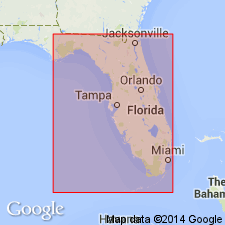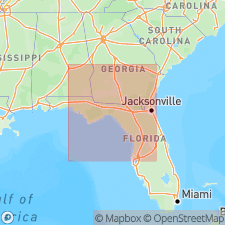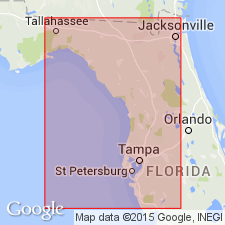
- Usage in publication:
-
- Penney Farms Formation
- Modifications:
-
- Named
- Dominant lithology:
-
- Limestone
- Dolostone
- Sand
- Clay
- AAPG geologic province:
-
- South GA-North FL sedimentary province
Summary:
Penney Farms Formation is a new name proposed for the predominantly subsurface basal unit of the Hawthorn Group in north and central FL. Type core is near town of Penney Farms in central Clay Co. Thickness at the type is 27 m. Maximum measured thickness occurs in Duval Co. where 47 m of the unit was penetrated. Estimated thickness here is 70 m. Consists of 2 unnamed members distinguished by their relative amounts of carbonates. These predominate in the lower member interbedded with sands and clays. Upper member is predominantly siliciclastic with interbedded carbonate beds. Contact between the two is gradational. Carbonates are variably quartz sandy, phosphatic, clayey dolostones. Mollusk molds common. Unit unconformably overlies the Eocene Crystal River Formation of the Ocala Group at the type section and in most of northern FL; in parts of central FL unit unconformably overlies the Oligocene "Suwannee" Limestone. Unit unconformably underlies the early Miocene Marks Head Formation. Age is early Miocene (Aquitanian) based on dateable fossils from two localities only. Unit appears to be equivalent in part to the Tampa Member of the Arcadia Formation (s. FL), the Parachucla Fm (GA,SC), and the Chattahoochee Fm (w. FL). The base of the Penney Farms may be slightly older than the base of the Pungo River Formation of NC.
Source: GNU records (USGS DDS-6; Reston GNULEX).

- Usage in publication:
-
- Penney Farms Formation
- Modifications:
-
- Geochronologic dating
- AAPG geologic province:
-
- Florida platform
Summary:
Authors use 87Sr/86Sr isotopic analyses in an attempt to resolve age relations of fossiliferous marine units that contain the remains of terrestrial vertebrates. Nearly identical, latest Oligocene ages were calculated for samples from the Penney Farms Formation in Marion Co. (24.6 Ma) and the Parachucla Formation at White Springs in Hamilton Co. (24.4 Ma).
Source: GNU records (USGS DDS-6; Reston GNULEX).

- Usage in publication:
-
- Penney Farms Formation
- Modifications:
-
- Biostratigraphic dating
- AAPG geologic province:
-
- Florida platform
Summary:
A marine limestone unit in the Penney Farms Formation at the Martin-Anthony road cut in Marion Co. contains an oreodont typical of the early late Arikareean NALMA (very early Miocene, late Aquitanian or early Burdigalian, 23-21 Ma). A small vertebrate assemblage collected slightly higher in this same section, the Martin-Anthony Local Fauna, is also late Arikareean in age. Though the Penney Farms has been correlated with the Parachucla Formation and the Tampa Member at the base of the Arcadia Formation (Scott, 1988), the land mammal faunas indicate that the Penney Farms is slightly younger. While all three are Arikareean, the Penney Farms is early Miocene; the Parachucla and lower Arcadia are late Oligocene.
Source: GNU records (USGS DDS-6; Reston GNULEX).
For more information, please contact Nancy Stamm, Geologic Names Committee Secretary.
Asterisk (*) indicates published by U.S. Geological Survey authors.
"No current usage" (†) implies that a name has been abandoned or has fallen into disuse. Former usage and, if known, replacement name given in parentheses ( ).
Slash (/) indicates name conflicts with nomenclatural guidelines (CSN, 1933; ACSN, 1961, 1970; NACSN, 1983, 2005, 2021). May be explained within brackets ([ ]).

